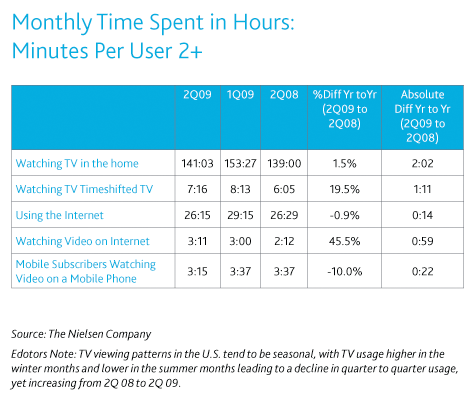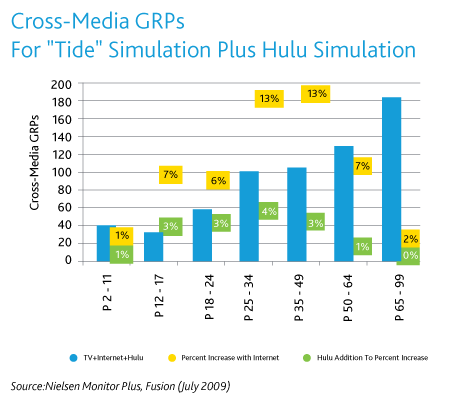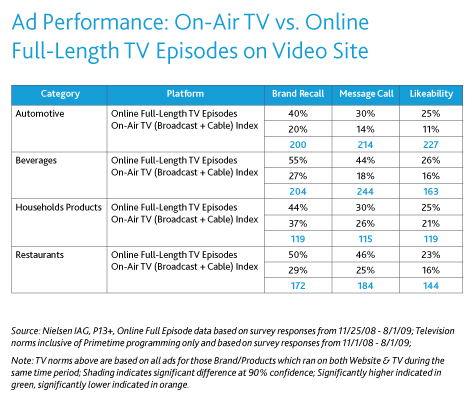
Jon Gibs, Vice President, Media Analytics, The Nielsen Company
SUMMARY: In the world of media, a new world order is forming. One where the Internet medium has matured from emerging and experimental to established and effective. The pathway to profitability for marketers will be determined by the ability to integrate mobile, TV and Internet traffic and advertising data into a holistic, effective, multi-strand fabric that blankets the consumer in a traceable, measurable way.
The Internet has moved from the “experimental” or “emerging media” categories to a mainstream media outlet. Online video portals like YouTube and Hulu transform the user interface. Facebook reshapes the contours of social media, helping friends connect and communicate. Apple rocked the commercial music world when it rolled out the iPod player.
The artificial media divide created by proprietary measurement tools is slowly going by the wayside as well, as providers realize that advertisers are right: media is media is media, and a common set of measurement solutions is the only sensible approach to align spending with effectiveness and allocate brand dollars.
Three screen view
Media is dominated by the power of three, as in the Big 3 screens: TV, Internet and mobile. The driver behind their continued growth is video. During Q2 2009, the mobile video audience increased 70%, time spent online expanded 46% over the prior year, and traditional TV consumption is at a seasonal all-time high of 141 hours per month.

It seem the more video feeds that are available, the greater the public appetite for video. Rather than replace a video platform, consumers are media multi-tasking on multiple platforms. Some 57% of Americans with home Internet access view TV and Internet simultaneously at least once a month. All told, they log some 2 hours and 39 minutes at each sitting. More than one-quarter of all home-based Internet time involves concurrent TV watching, which explains why both Internet and TV consumption are enjoying an upward trend.
The advertising ecosystem
Like any new medium, the Internet has fought to gain a foothold with media buyers, to get a fair share of the advertising pie, to establish its efficacy at delivering prospects, to make the case for market share, and to re-shape purchasing habits and media schedules.
By all measures, that push for legitimacy has been successful. The Internet now accounts for 7% of Q2 2009 advertising dollars across media, or $2.1 billion, gaining ground against more established media formats like newspapers with a 9% share or radio, outdoor and free-standing inserts with an 8% share. Technology and media-oriented advertisers are bumping up their Internet ad budgets, and even the U.S. government has jumped on the bandwagon, deploying online for military recruitment advertising.
Perhaps more remarkably, these gains have been made even as overall advertising expenditures shrunk by 10%. Magazines (-27%) and newspapers (-22%) were the hardest hit, while Internet and TV took minor blows, down by just 3% each. The news was healthier on the market share front, where TV gained four share points, garnering almost two-thirds of all ad dollars.
Measuring value
As video, audio and text converge on digitally-based networked delivery systems, share of media will become a passé concept, supplanted by anytime, anywhere availability. The Internet has proven its organic ability to adapt and evolve accordingly, but there remains a disconnect between ad dollars committed to the medium and consumer time spent with the medium.
For example, people spend 87–90% of viewing time in front of the TV screen, and advertisers assign a somewhat disproportionate 89–92% of ad dollars to that medium. By contrast, the Internet commands between 10–13% of consumer viewing time, but only receives 8–11% of ad dollars. Converting percentage points to dollars, that spending level represents an almost $4.4 billion shortfall in Internet advertising.
Equalizing measures
Accurately measuring Internet ad effectiveness has posed a major marketing quandary over time. From the earliest days of measuring click-throughs, the maturing Internet medium now proposes to equalize measurement with other media formats based on audience delivery in two possible ways: time-based currency and gross-ratings points. Both possible measures emphasize overall campaign delivery rather than a specific unit.
One idea that has surfaced as a possible measurement unit is the concept of dwell time—the seconds a person is exposed to a given brand during an advertising flight. A Web site would be paid based on the total time of unique exposure to a consumer rather than the number of impressions. In theory, this would reduce clutter, minimize the need for extra page views designed to generate inventory, and in turn increase the average cost per thousand (CPM). Since CPM is a common industry metric, this should facilitate TV comparisons.
Online GRPs
Another approach to homogenizing metrics for easier comparison is to develop an online gross-ratings points (GRP) system for the Internet. The GRP calculation is pretty straightforward: ad impressions divided by total population. Using Tide’s May 2009 TV and Internet ad campaigns, we simulated how the campaign was delivered across multiple demographics to illustrate the power of a GRP-based system. Adding the Internet boosted television-only ratings across the board—especially in the coveted core 25–49 demographic, which demonstrated a 9–10% increase in the total campaign GRPs.

Utilizing both a time-based measure and GRPs would better reflect the value of ad formats within each media, while also correcting for TV time constraints. A cross-media metric would recognize the varying degrees of interaction with each media, as well as the array of different ad formats deployed. Internet properties should view cross-media measurement from two core areas: cross-media post-buy analysis and “share shift”.
Share shift
In a classic case of “what if”, a new share shift model from Nielsen uses fusion data and campaign reach and frequency tools to standardize and scale the process of evaluating changes to ad campaign reach, frequency and GRPs prompted by a funding shift from medium to medium—i.e., “what happens if I move X% of the dollars from TV to the Internet”.
Creating share shift simulations enables advertisers to calculate delivery value. Complementing that with a post-buy analysis of cross-media reach and frequency can influence a hard-nosed media buyer with powerful empirical facts. Together, these analyses predict how, and to what degree, the Internet will impact a campaign and then demonstrates precisely how it does so.
Cross-platform engagement
While the two core issues in cross-media advertising—how many ads are served and who sees them—are critical elements, one final question remains: what actually works? Nielsen IAG uses three core metrics to assess the synergies offered by a cross-platform campaign that a consumer sees on both TV and online:
- Brand recall—did those exposed to the ad remember the brand the next day?
- Message recall—did those exposed to the ad remember the primary message the next day?
- Likeability—did those exposed to the ad remember the brand the next day and report liking the ad “somewhat” or “a lot”?

An analysis of ad performance in four different categories for on-air TV versus online full-length TV episodes revealed a remarkable pattern: Internet video impressions were materially stronger than traditional TV on the important measure of brand impact. In fairness, the novelty of online video may have artificially inflated results somewhat, as would artifacts of the medium itself such as an inability to skip online video ad units. But there is no denying the strong showing.
Getting creative
The great debate among agency creative types surrounds the issue of Internet advertising. Does it demand a unique treatment, or can costly TV creative translate effectively across media? Surprisingly, at least for the food and beverage category, evidence shows that, across all brand metrics, repurposed TV ads performed better on average than in-stream Web original video ads or original flash animation designed exclusively for the Web.
The higher production values of TV ads might have influenced results. So too, might have the superior creative treatments of TV ads. Although, given the hundreds of ads analyzed, the impact of creative differences was likely minimized.
Media measurement in today’s multi-platform environment underscores Nielsen’s commitment to developing Anytime Anywhere Media Measurement (A2M2) designed to deliver comprehensive cross-platform, consumer-centric insights.
- Download the full report, The Shifting Media Landscape: Integrated Measurement in a Multi-Screen World.



